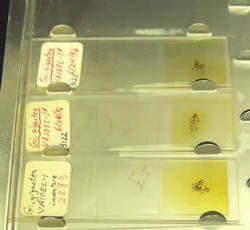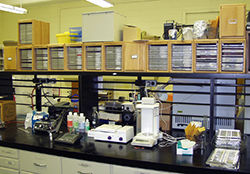Permanent Slides
Mounting Spores on Glass Slides
The procedure to mount spores on slides described here is based on the assumption that PVLG-based mountants are being used:
Add Drop of PVLG and Melzer's Reagent
Add two small drops (0.5-0.75 cm in width) to slide, one of PVLG and the other of PVLG + Melzers reagent. Add spores, keeping water to a minimum if using pipette. Let stand for at least 5 minutes to let surface of drop dry slightly (increasing viscosity of edges, reducing flow when coverslip is added).
 |  |
Coverslip
Place a coverslip gently on drop of PVLG recipe and press lightly. Place another coverslip on drop of PVLG and Melzer's Reagent.

Using the blunt tip of a pencil, forcep, or needle, press directly on each coverslip over individual spores. When this is done under a dissecting microscope, each spore can be crushed to varying
degrees (thus exposing hard-to-see thin flexible inner layers if present). Add more mountant to edge if needed to fill in. After 5 days at room temp or two days at 60°C, mountants harden.
Slide Label

The slide label should include as a minimum the following information: (1) genus name and specific epithet if known, (2) date, (3) code number for culture of origin. More detailed information on source of the specimen is needed if a code number is not linked to a specimen database or some other record-keeping method.
Slides are stored flat in aluminum trays in oak boxes and organized by genus and species. Data on each slide and slide location are stored in the INVAM database.